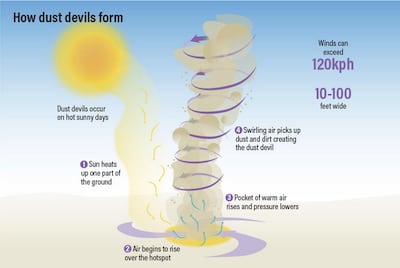There are two explanations for the weather phenomenon known as dust devils. The first is scientific, the other is a folk story possibly thousands of years old.
Both versions agree that to be caught up in one can be dramatic. Dashcam footage shot this week on the E11 motorway near Al Rahba, and shared widely on social media, showed a particularly powerful dust devil.
Drivers reduced their speed to a crawl as a vortex of dust and debris enveloped their vehicles on the Abu Dhabi-bound carriageway.
Scientifically, the dust devil is part of the whirlwind family, where it might be described as a little brother to tornadoes and waterspouts.
According to the National Centre for Meteorology and Seismology in Abu Dhabi, the dust devil is “a weather phenomenon (that) occurs on arid areas and especially in clear sky and warm days”.
In a 2011 report on dust in the UAE, the centre observed they can throw up "dust and sand or any non-coherent objects on the ground surface, causing the cloud of dust to spin rapidly in the form of a small-diameter cylinder vortex in clockwise or counter-clockwise".
Dust devils typically form when hot air rising from the surface meets cooler, low pressure air around it. As the hot air continues to rise, it forms a vortex, pulling in more hot air until a tall spinning column is formed.
Eventually the cooler air overcomes the heat, causing the dust devil to collapse. The biggest columns can reach up to 2,000 metres - more than double the height of the Burj Khalifa.
Desert areas are particularly prone to dust devils, where they are also much more easily seen because of the loose sand that gets sucked in.
The alternative explanation is that they are created by spirits. It is a mythology found in almost every culture where dust devils are experienced.
In Arab countries such as the UAE, they are attributed to djinn, the spirit race that lives alongside humans but are rarely seen.
Although the first stories are pre-Islamic, djinn are mentioned in the Quran, which says they are created from smokeless fire, and like mankind can be both good and evil.
In Egypt they are known as fasset el 'afreet, or ghost winds, and in Kenya as ngoma cia aka, or the evil of women.
The idea that dust devils are sinister is widespread. Navaho Native Americans believe they are the evil left behind by the dead. To come in contact with one will bring great misfortune.
Among Australian aboriginals, they are used to warn misbehaving children, with the threat they will be abducted by spirits. Brazilian folklore tells of a mysterious youth called Saci, with powers to grant wishes and who appears and disappears inside a dust devil.
In northern India, parts of Pakistan and Bangladesh, they frequently occur in late Spring, just before the arrival of the Monsoon, and are called Kali Andhi in both Hindi and Urdu, meaning “black storm”.
There is even an extra-terrestrial version of the dust devil, found on the arid surface of Mars, which experiences extremes of hot and cold.
Martian dust devils have been detected by Nasa's Spirit and Opportunity rovers, which have photographed them. The Martian version is believed to be more numerous and violent – with potential to investigate them further when the Hope spacecraft on the Emirates Mars Mission arrives to orbit the Red Planet in 2021.



